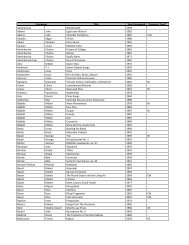From the Top - San Francisco Contemporary Music Players
From the Top - San Francisco Contemporary Music Players
From the Top - San Francisco Contemporary Music Players
You also want an ePaper? Increase the reach of your titles
YUMPU automatically turns print PDFs into web optimized ePapers that Google loves.
shaping of <strong>the</strong> text he sets. He wrote his own libretto for Gatsby, but he<br />
has also engaged with poets ranging from <strong>the</strong> German romantic Holderlin<br />
to <strong>the</strong> legendary sixteenth-century poet Mirabai, whose ecstatic verse<br />
inspired <strong>the</strong> composer’s Mirabai Songs (1982) and whom he compares<br />
to Emily Dickinson as a creator of “texts which draw you into <strong>the</strong> poet<br />
as a character.” In a program note for his 1991 song cycle Th e Rewaking<br />
(1991), on texts by William Carlos Williams, Harbison explains: “My<br />
choice of text for a vocal piece usually happens as follows: 1) <strong>the</strong> poems<br />
are inadvertently memorized, and won’t go away, 2) <strong>the</strong>y begin to run<br />
parallel to a musical shape I already have in mind, 3) <strong>the</strong>y clarify and enlarge<br />
upon what began as a purely musical impulse.” Harbison’s “purely<br />
musical impulses” tend toward <strong>the</strong> dramatic, and <strong>the</strong>y have resulted in<br />
music so engaging that he has sometimes been called upon to explain (or<br />
explain away) its popularity. His response is characteristically thoughtful.<br />
He writes, “[my works] share a commitment to spontaneity, naturalness,<br />
and memorability. Th eir surfaces may be more transparent than<br />
<strong>the</strong>ir substance. Th eir apparent simplicity is an invitation to wade in,<br />
but <strong>the</strong> hope is that some will also feel an undertow.”<br />
For forty years, Harbison has taught at <strong>the</strong> Massachusetts Institute of<br />
Technology, where in 1995 he was named an Institute Professor (<strong>the</strong><br />
highest academic distinction off ered to resident faculty). In addition, he<br />
has won <strong>the</strong> Heinz Award for <strong>the</strong> Arts and Humanities, <strong>the</strong> Harvard Arts<br />
Medal, awards from <strong>the</strong> American Composer’s Orchestra, <strong>the</strong> American<br />
<strong>Music</strong> Center, and <strong>the</strong> Kennedy Center, as well as a MacArthur Fellowship.<br />
He has served as composer-in-residence all over <strong>the</strong> United States<br />
and has conducted such orchestras as <strong>the</strong> St. Paul Chamber Orchestra,<br />
Los Angeles Philharmonic, Boston Symphony, and <strong>the</strong> Handel and<br />
Haydn Society. He is currently president of <strong>the</strong> Aaron Copland Fund<br />
for <strong>Music</strong>, Acting Artistic Director of Emmanuel <strong>Music</strong>, and artistic<br />
director of <strong>the</strong> Token Creek Chamber <strong>Music</strong> Festival, held on <strong>the</strong> farm<br />
in Wisconsin where Harbison does much of his composing.<br />
Harbison, The Seven Ages (2009)<br />
for mezzo-soprano, fl ute, clarinet, violin, cello, piano, and vibraphone<br />
Harbison composed Th e Seven Ages during June and July of 2008, at <strong>the</strong><br />
Aspen and Tanglewood <strong>Music</strong> Festivals. Each of <strong>the</strong> six songs in <strong>the</strong><br />
cycle sets a text by Louise Glück, whose poem “Relic” was also incorporated<br />
into <strong>the</strong> composer’s Fifth Symphony. Describing his attraction to<br />
SAN FRANCISCO CONTEMPORARY MUSIC PLAYERS<br />
16<br />
her verse, Harbison observes that “every Glück poem...could be music,<br />
this in spite of <strong>the</strong> fact that her poems are often much larger than those<br />
composers tend to set. Her words are clear, strongly placed, deeply felt,<br />
vivid–all <strong>the</strong> things needed to suggest rhythm, melody, and a kind of<br />
‘symphonic’ structure.”<br />
As Harbison observes, <strong>the</strong> poet’s appeal is not just aes<strong>the</strong>tic but also, in a<br />
sense, psychological: “While visiting with <strong>the</strong> Tanglewood Composition<br />
Fellows in <strong>the</strong> summer of 2008...Louise Glück gave colorful, reluctant<br />
testimony about her writing habits. Her work leaves her periodically,<br />
reappearing inconveniently and unbidden. Th is account confi rmed, for<br />
me, <strong>the</strong> affi nity I feel for her cadence, voice, and material. Th e Seven<br />
Ages, taken hold in <strong>the</strong> midst of an active summer schedule, after a<br />
‘blank’ period–which always feels irrevocable–felt like an urgent conversation<br />
with <strong>the</strong> poet. After living in <strong>the</strong>se poems it was diffi cult to leave<br />
<strong>the</strong>m.”<br />
Th e Seven Ages was commissioned by <strong>the</strong> Serge Koussevitsky Foundation<br />
in <strong>the</strong> Library of Congress, and is dedicated to <strong>the</strong> memory of Serge and<br />
Natalie Koussevitsky. Th e composer also wishes to express his gratitude<br />
“to Louise Glück for her poems, both in this piece and wherever <strong>the</strong>y<br />
have appeared, and to <strong>the</strong> Wylie Agency for use of six of <strong>the</strong>m in this<br />
piece.”<br />
SAN FRANCISCO CONTEMPORARY MUSIC PLAYERS<br />
�<br />
Please join us for a reception in <strong>the</strong> lobby after <strong>the</strong> concert. Scores<br />
from tonight’s program will be on display.<br />
17




